Related Research Articles

The Orteig Prize was a reward offered to the first Allied aviator(s) to fly non-stop from New York City to Paris or vice versa. Several famous aviators made unsuccessful attempts at the New York–Paris flight before the relatively unknown American Charles Lindbergh won the prize in 1927 in his aircraft Spirit of St. Louis. However, a number of people died who were competing to win the prize. Six men died in three separate crashes, and another three were injured in a fourth crash. The Prize occasioned considerable investment in aviation, sometimes many times the value of the prize itself, and advancing public interest and the level of aviation technology.
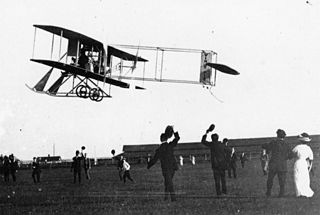
The Vin Fiz Flyer was an early Wright Brothers Model EX pusher biplane that in 1911 became the first aircraft to fly coast-to-coast across the U.S., a journey that took almost three months.
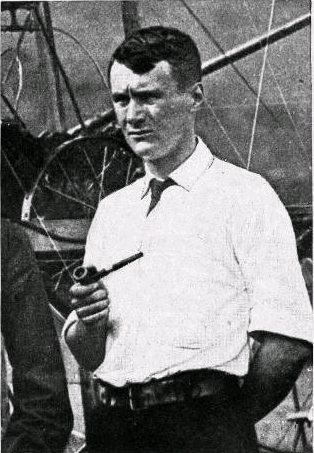
Thomas Etholen Selfridge was a first lieutenant in the U.S. Army and the first person to die in an airplane crash. He was also the first active-duty member of the U.S. military to die in a crash while on duty. He was killed while seated as a passenger in a Wright Flyer, on a demonstration flight piloted by Orville Wright.
This is a list of aviation-related events from 1911:

John Rodgers was an officer in the United States Navy and a pioneering aviator.
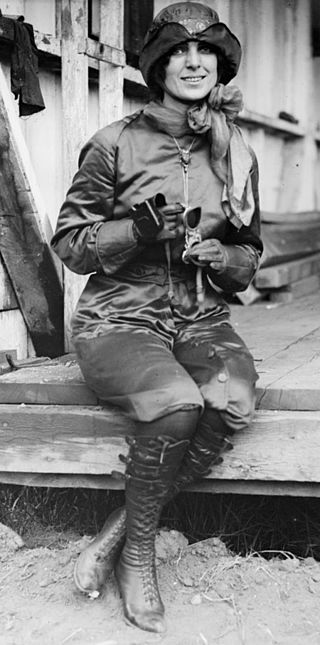
Harriet Quimby was an American pioneering aviator, journalist, and film screenwriter. In 1911, she became the first woman in the United States to receive a pilot's license and in 1912 the first woman to fly across the English Channel. Although Quimby died at the age of 37 in a flying accident, she strongly influenced the role of women in aviation.

Eddie August Henry Schneider was an American aviator who set three transcontinental airspeed records for pilots under the age of twenty-one in 1930. His plane was a Cessna Model AW with a Warner-Scarab engine, one of only 48 built, that he called "The Kangaroo". He set the east-to-west, then the west-to-east, and the combined round trip record. He was the youngest certificated pilot in the United States, and the youngest certified airplane mechanic. He was a pilot in the Spanish Civil War in the Yankee Squadron. He died in an airplane crash in 1940, while training another pilot, when a Boeing-Stearman Model 75 belonging to the United States Navy Reserve overtook him and clipped his plane's tail at Floyd Bennett Field.

Bertrand Blanchard Acosta was a record-setting aviator and test pilot. He and Clarence D. Chamberlin set an endurance record of 51 hours, 11 minutes, and 25 seconds in the air. He later flew in the Spanish Civil War in the Yankee Squadron. He was known as the "bad boy of the air". He received numerous fines and suspensions for flying stunts such as flying under bridges or flying too close to buildings.

Lincoln Beachey was a pioneer American aviator and barnstormer. He became famous and wealthy from flying exhibitions, staging aerial stunts, helping invent aerobatics, and setting aviation records.

Calbraith Perry Rodgers was an American aviation pioneer. He made the first transcontinental airplane flight across the U.S. from September 17, 1911, to November 5, 1911, with dozens of stops, both intentional and accidental. The feat made him a national celebrity, but he was killed in a crash a few months later at an exhibition in California.

Robert George Fowler was an early aviation pioneer and was the first person to make a west-to-east transcontinental flight in North America in stages.
A transcontinental flight is a non-stop passenger flight from one side of a continent to the other. The term usually refers to flights across the United States, between the East and West Coasts.

The Wright Exhibition Team was a group of early aviators trained by the Wright brothers at Wright Flying School in Montgomery, Alabama in March 1910.
The Junior Birdmen of America was a national organization for boys and girls interested in aviation and model plane building, founded and promoted by the Hearst Communications newspaper chain, with the cooperation of the U.S. Bureau of Air Commerce.

The Los Angeles International Air Meet was among the earliest airshows in the world and the first major airshow in the United States. It was held in Los Angeles County, California, at Dominguez Field, southwest of the Dominguez Rancho Adobe in present-day Rancho Dominguez, California. Spectator turnout numbered approximately 254,000 over 11 days of ticket sales. The Los Angeles Times called it "one of the greatest public events in the history of the West."
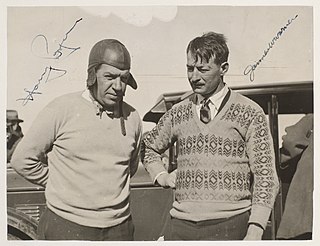
James Warner (1891–1970) was the radio operator on the aircraft Southern Cross piloted by Charles Kingsford Smith for the first trans-Pacific flight in 1928, during which radio was first used successfully on a long distance flight.
Cecil Stanley Grace was a pioneer aviator who went missing on a flight across the English Channel in 1910.
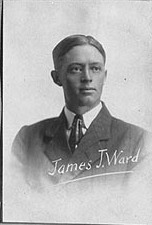
James J. Ward was a pioneer aviator who made one of the earliest attempts at transcontinental flight. He was also known as Jimmie Ward.
References
- 1 2 "Prize Competitions and NASA's Centennial Challenges Program" (PDF). NASA. 2005. Archived from the original (PDF) on 2007-07-03. Retrieved 2007-09-23.
- ↑ "Flier, Seeking to Reach San Francisco, Lands at Calicoon Late in the Afternoon". New York Times . September 15, 1911. Retrieved 2010-11-25.
James J. Ward, who left New York for San Francisco Wednesday, flying for the W.R. Hearst $50,000 prize for a transcontinental flight, reached Callicoon, N.Y., a few miles from here, at 4:35 o'clock this afternoon. He covered 59 1-10 miles in 57 minutes, having left Middletown, N.Y., at 3:38 o'clock.
- ↑ "Ward Quits Coast Flight. Comes to Grief at Addison". New York Times . September 23, 1911. Retrieved 2010-11-26.
- ↑ "Robert G. Fowler, Aviator, 81, Dead; Pilot Flew Biplane From West to East Coast in 1911". New York Times . Associated Press. June 16, 1966. Retrieved 2007-06-21.